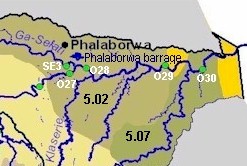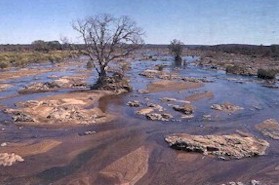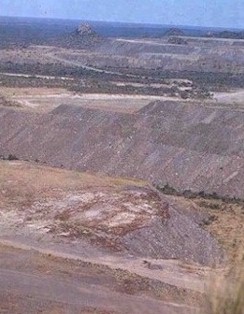|
Ecoregion and River Characteristics
Mopane bushveld characterises ecoregion 5.02. It is a lowland area (200-600 m amsl) with rolling plains, moderate rainfall (400-800 mm per year) and high temperatures (20-22°C and above). Loamy sand and clay soils overlie iron, jaspilite, granite, sandstone and shale. In ecoregion 5.07, sweet lowveld bushveld is dominant, on shallow clayey soils overlying a variety of geological types including mudstone, sandstone and shale. Moderate rainfall (400-800 mm per year) and high temperatures (20-22°C and above) characterize this region.
The first stretch of the Olifants River in this section is a broad, sandy channel with large trees,
like wild figs and mahogany, on the banks. The river changes as it flows eastwards through
the Kruger National Park, forming several channels with permanent reed-grown islands.
Dominant
tree species on the islands are Common Cluster (Ficus sycomores) and Jakkalsbessie (Diospyros mespiliformis). The Letaba River joins the Olifants River west of the Olifants Rest Camp. A narrow gorge forms where the Olifants River flows through the Lebombo Mountains.
|
|
Present Ecological State
|
|

|
Ecoregion 5.02
The Olifants River is generally in a
fair
state with fish and invertebrates occasionally reflecting
poor
conditions.
The Ga-Selati is generally in a
fair
state with the state of fish and riparian vegetation being
poor
.
Ecoregion 5.07
In this region the Olifants River in general is in a
fair
state with
good
riparian vegetation.
|
|
Drivers of Ecological Change (Land-use activities)
|
Ecoregion 5.02
Sediment, from upstream activities including overgrazing and industrial and mining activities, accumulates in the Phalaborwa Barrage. When the barrage is flushed out from time to time, large quantities of sediment are released. This causes severe damage to in-stream habitats and biota in the downstream part of the Olifants River. Fish die from oxygen depletion or are smothered by silt clogging their gills.
|

|

|
Heavy metals and chlorides from industrial and mining origin in the Phalaborwa area may reach unacceptable levels during low flow periods. Upstream abstractions from the Ga-Selati River cause flow to cease during winter. The lower section of the Ga-Selati is impacted by upstream water abstractions.
Ecoregion 5.07 and 6.01
The water quality of the Olifants River in this section is lower than is desirable, with high concentrations of dissolved salts having accumulated due to the activities in the upper reaches of the catchment.
The Massingire Dam, across the border in Mozambique, causes the river flow to decrease during floods and results in sediment being deposited in the gorge.
|
|
Desired Ecological State and Response by Resource Managers
Given the conservation importance of this region, the desired ecological state of the Olifants River is set at
good
. The reason why it is not natural is because of the intensive utilisation of the water resource in the upper and middle parts of the catchment, which deems a natural state for the lower part unrealistic.
Water quality should be improved. Silt should be cleaned from the Phalaborwa Barrage. Flow regulation can be improved to reduce negative impacts on downstream fish and invertebrate communities.
Lantana (Lantana camara), wild tobacco (Nicotiana glauca), common cocklebur (Xanthium strumarium) and castor oil bush (Ricinus communis), amongst others, are declared weeds and should be eradicated.
Private land owners have formed a conservancy and set aside more than 33 000 ha of land (from Gravelotte to Phalaborwa) to be managed as the Selati Game Reserve. This change in land use is expected to improve river health conditions in this area and downstream. The long-term aim of this conservancy should be to reach a
good
ecological state for the Ga-Selati.
|
|





|
|























